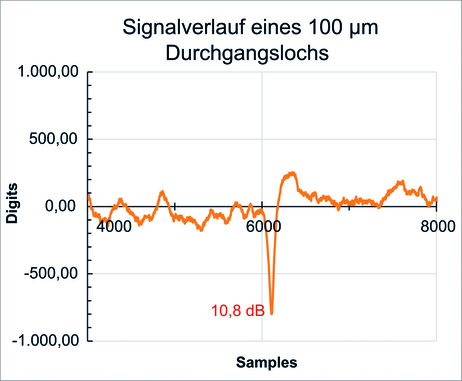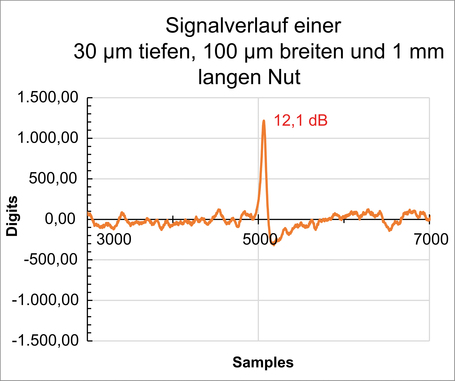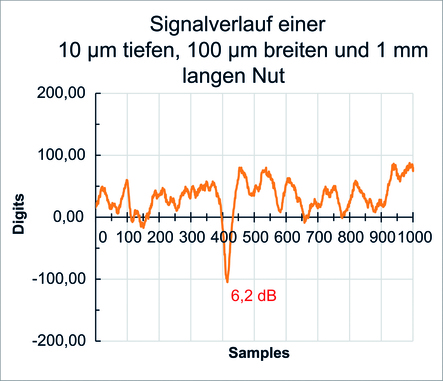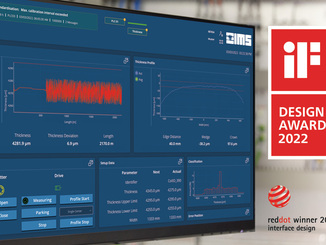
The demands placed on steel as a material are constantly increasing due to the ongoing development of the material and its processing methods. This also applies to the degree of purity of the steel.
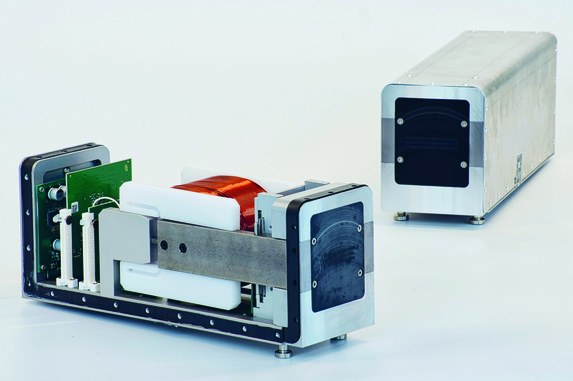
© IMS
In line with the growing demands on the purity of strip steel, precise management of the production processes is essential for the production of high-quality end products in order to provide the finishing industry with flawless starting materials with homogeneous material structures. To ensure this, it is important to determine various parameters over the entire length of the strip.
A selective material inspection at the ends of the strip is not sufficient to reliably prevent material defects in the end products as well as possible damage to tools in the downstream forming processes.
Task
During steel production and the subsequent casting process, inclusions enter the melt. Some of these non-metallic particles remain in the steel products produced.
During the subsequent rolling processes, these internal defects are not rolled out of the steel, but take on an elongated shape due to material deformation.
The degree of purity of steel is defined by the quantity, particle size and spatial distribution of these non-metallic particles remaining in the strip. If these do not come to the surface of the measured material as open defects, they cannot be detected with optical measuring systems.
In order to be able to reliably detect such internal inclusions and shell defects, the specific task for IMS was to develop a measuring system that detects the described defects continuously, during the ongoing production process, in a non-contact and non-destructive manner.
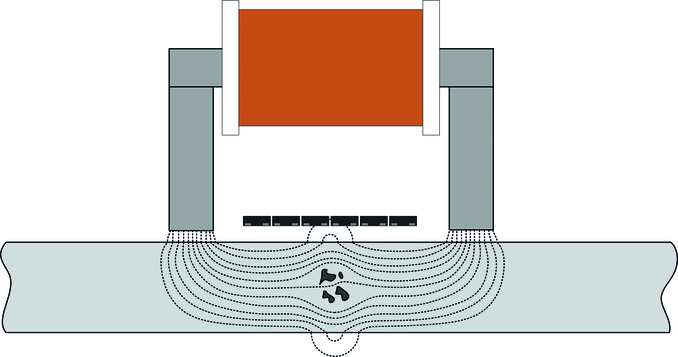
© IMS
Technical basis of the Inclusion Detection System (IDS)
If there are local areas of significantly low permeability in the material, caused by non-metallic inclusions, cracks and indentations on the surface, the magnetic resistance increases at this point. Part of the magnetic flux is thus forced to the material surface. Due to the difference between the relative permeability of the material and the surrounding air, pronounced magnetic refraction occurs. The extent of the scattered field emerging from the material surface is therefore significantly larger than the causal defect, which enables its detection.
The developed Inclusione Detection System (IDS) for internal inclusions provides complete flux leakage testing during production operation. Electromagnets are used to magnetize the material. These can be adapted in their performance to the nature, structure and geometry of the inspected material as well as switched off for maintenance and cleaning purposes. The detection of the stray fields is done by means of GMR sensors.
The sensors used are GMR differential sensors (gradiometers). These consist of four individual GMR sensors interconnected in the form of a Wheatstone measuring bridge. Two of each of these sensors are spatially combined. A differential signal is formed depending on the difference in magnetic field strength between the two sensitive areas.
The use of gradiometers allows a significantly higher amplification compared to absolute sensors (magnetometers), since external fields have no influence on the sensor signal. This allows particularly small local magnetic field inhomogeneities to be detected.
In the IDS measuring system, magnetization is used transverse to the rolling direction. The choice of magnetization direction is based on laboratory measurements with artificial errors. Through holes of different diameters and grooves with a length of 1 mm, a width of 100 µm and variable depth were defined as such.
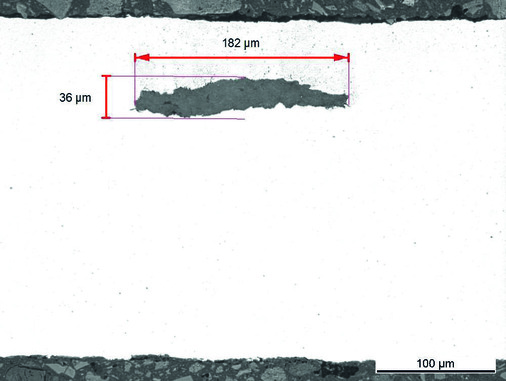
© IMS
The internal inclusions occurring in cold-rolled strip usually take on elongated shapes due to the severe deformation. Thus, grooves correspond most closely to the defects that actually occur.
For holes corresponding to compact defects, approximately equivalent results were obtained with all magnetization directions. For grooves, significantly better signal-to-noise ratios could be achieved with magnetization transverse to the rolling direction. This is easily explained by the larger defect cross-section in this direction.
Magnetization at a 45° angle to the rolling direction is not a compromise, as it degrades the signal-to-noise ratio for compact defects compared to parallel magnetization without improving the signal-to-noise ratio for elongated defects.
With magnetization transverse to the rolling direction, the maximum yoke width of the magnet is limited. Due to a suitable magnetic field homogeneity, the yoke width was chosen to measure a 48 mm wide area each time. Consequently, several magnets are necessary to cover the different material widths. Since no measurement is possible in the area of the pole shoes of the magnets, the sensor modules are arranged in two rows for gap-free coverage.
Structure of a sensor block
One magnet and the sensor line inside each magnet were combined to form a compact sensor module. Easy maintenance, repair and scalability of the measuring system is thus guaranteed.
A sensor module contains the sensors, the amplification and filtering of the sensor signals, A/D converters as well as the control of the electromagnet and stabilized voltage supplies. The reproducible and fast installation of the sensor modules on the measuring system takes place via quick clamps in connection with fitting screws. Mechanical adjustment is not required due to the precise manufacturing and assembly of the individual module components. The GMR sensors are cast into a sensor block within a protective and stabilizing aluminum frame. This makes it more difficult for dirt to adhere and provides protection against mechanical damage.
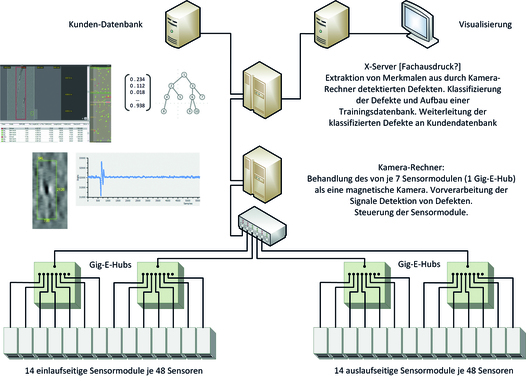
© IMS
The sensor modules comply with protection class IP 64, which allows direct use in harsh environments. The modular design ensures easy replacement of the sensor block without adjustment work.
A sensor module has an outer width of 95 mm, which provides gapless coverage of the material with two sensor module rows. Each sensor module has 48 GMR differential sensors in the center of the magnet. The distance of the sensors across the rolling direction is 1 mm. This is sufficient, since the size of the stray fields of even the smallest defects is above 1 mm.
The resolution of such a sensor arrangement is thus sufficient for the detection of even the smallest defects. At the same time, the sensors used are more sensitive compared to smaller sensors with higher spatial resolution. This makes it easier to detect particularly weak signals of small defects. The defects detected by a sensor are determined by the signal amplitude.
The overall system is hierarchical. The individual levels work in a task-oriented manner and are interconnected via fast network technology. The sensor signals are converted analog-digital with a sampling rate of up to 187.5 kHz at a resolution of 15 bits. Length-dependent scanning is performed with a constant longitudinal resolution (rolling direction) of 0.1 mm.
The digitized sensor signals from eight sensor modules are fed to a common Gig-E hub and converted to the Gig-E camera standard. The Gig-E hubs are connected to a camera computer. This camera calculator has the following tasks:
– Signal preprocessing
– Detection of the errors
– Characteristic calculation
– Classification
– Control and adjustment of the sensor modules
The database server is superimposed on this camera computer. The database server stores the error images and includes the production and training database. The visualization of the errors as well as the connection of the customer database is done via the database server.
Production engineering execution
After extensive laboratory tests and a successfully completed pilot phase, the now market-ready measuring system with 28 sensor modules (maximum material width 1,344 mm) was installed in a tinning line and successfully put into operation.
Product data
Strip thickness 0.1 to 0.6 mm (maximum 1.0 mm)
Belt width 600 to 1250 mm (measuring width 1344 mm)
Belt speed Maximum 1000 mm/min. At full resolution
Measuring distance > 0.5 mm
Measurement accuracy
Detectable error size Hole; 70 µm diameter
Groove 10 µm depth; 100µm width; 1000 µm length at 250 µm strip thickness
Minimum error size must be determined depending on the application.
Distance influence 1 dB / 100 µm
Reproducibility > 98 %
The measurement is performed on a deflection roller with two rows of sensor modules. The position of the sensor modules can be adjusted to different material thicknesses using servo motors.
To ensure mechanical stability, the sensor module rows and their carriers are kept at a constant temperature by means of water. The water cooling system also serves to dissipate the waste heat from the sensor modules.
The measuring system also has a pneumatic drive to swivel the sensor rows completely on and off the strip surface. The drive is automatically activated in case of danger of collision with the material to be measured for quick lifting of the measuring system from the strip surface.
The distance of the sensor modules to the strip surface is permanently monitored by three capacitive distance sensors per sensor module row. As an additional safety device, the measuring system has an optical wrinkle detector. This is a laser light barrier that is installed in the belt run 10 to 20 m in front of the measuring point. In case of wrinkles in the measured material, the sensor lines are swung off.
The measuring system can be moved to a parking position outside the plant. In this position, the sensors are automatically calibrated and maintenance work can be carried out while the system is running. During the automatic calibration, all sensors are normalized to a defined magnetic sensitivity and defective sensors are detected.
Measurement results
Three figures show the raw signal characteristics of artificial defects: a hole with a diameter of 100 µm and surface grooves with a length of 1 mm, a width of 100 µm and depths of 30 µm and 10 µm respectively in 200 µm thick steel strip at a measuring distance of 500 µm and a speed of 500 m/min.
|
|
|
|
Surface defects on the opposite side of the material to the measuring system can also be detected.
The last curve shows the raw signal of grooves with dimensions 1 mm x 100 µm x 25 µm in 200 µm thick steel strip. The first groove is located on the side facing the measuring system, the second on the opposite side of the material.
The defect position within the material has only little influence on the signal-to-noise ratio of defect signals, as can be seen in the figure.
Operating measurement
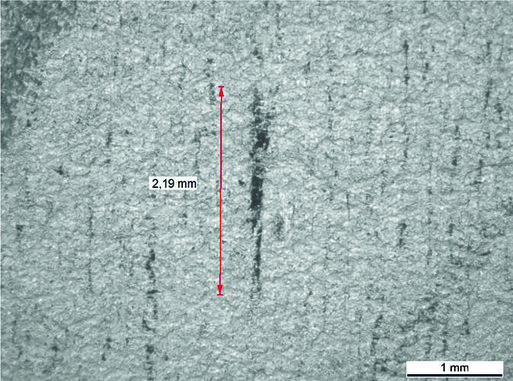
© IMS
The measured internal inclusions are evaluated as follows:
1. due to the error size (amplitude/volume)
2. on the basis of classification (for example, shells, cracks, overlaps, M defects, scratches, indentations).
Some detected inclusions were precisely localized in the laboratory by magnetic particle inspection and then examined by making three sections each transverse to the rolling direction.
By using high-quality measurement electronics as well as advanced image processing, a high-resolution measurement system for internal defects and external material damage was developed with the Inclusion Detection System (IDS) from IMS Messsysteme.
The market-ready IDS is available to cold rolling mills of strip steel for comprehensive evaluation of the degree of cleanliness. The maximum strip thickness at full sensitivity is 1 mm. The inspection system is scalable for any strip width and can be individually adapted to the customer’s specification.
The image processing used with feature calculation and classification distinguishes the defects based on their size and defect type. The classification is adapted to the respective material as well as the customer specification.
The use of an IMS (Inclusion Detection System) prevents the delivery of defective material and ensures perfect product quality for the end customer. In addition, the measurement results are used for the optimization of the starting material stages. By improving quality and output, resources are conserved and costs reduced.
Author:
Sonja Koch
Web:
ims-experts.com

